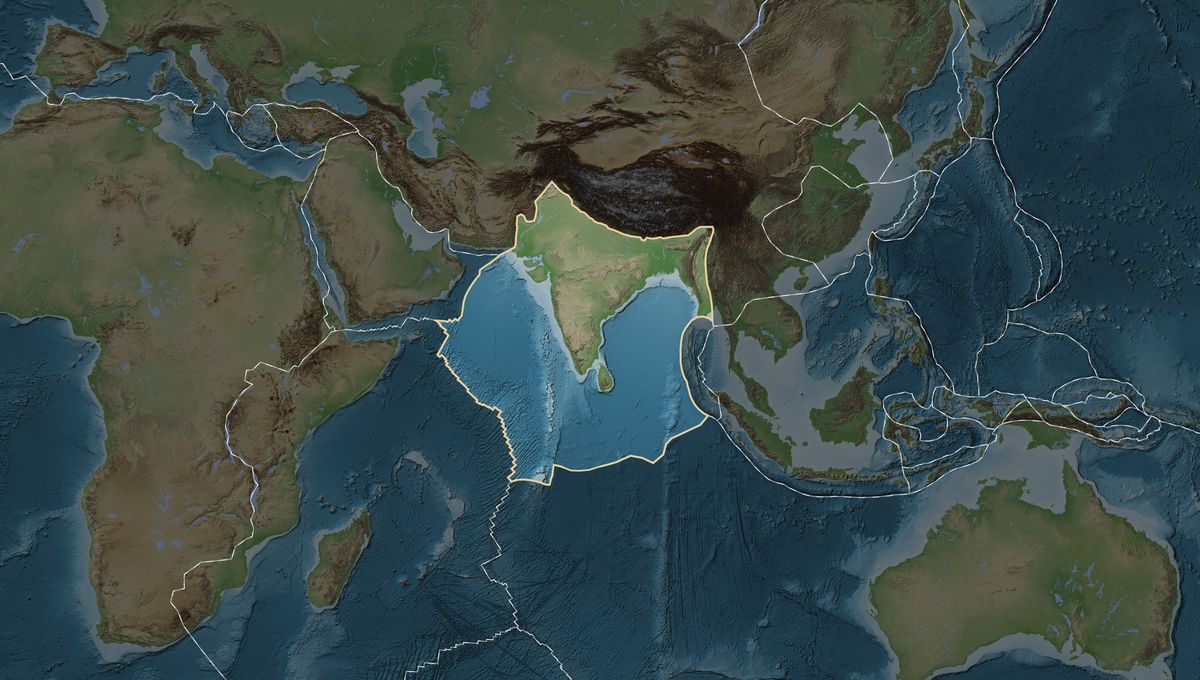
The Indian Continental Plate could be splitting in two, a new study proposes. However, instead of breaking vertically, like east Africa, to form a new microcontinent, India could be sheering horizontally as it runs into Eurasia, separating into two layers each about 100 kilometers (60 miles) thick.
The Himalayas form the world’s mightiest mountain range, but their really distinctive feature is the Tibetan Plateau behind them.
Considering this, you might think we would understand the process that is producing them better than we do. Everyone (ok, maybe flat-Earthers aside) agrees that both features are a result of India moving north at a rate of 1-2 millimeters/year (0.04-0.08 inches/year), driving into Eurasia in the process. Over 60 million years, that sort of slow motion can force mountains to an immense height. Beyond this, however, there is plenty of debate.
One theory is that the Indian Plate is too buoyant to sink into the mantle, causing it to slide under the Eurasian Plate, producing the bulge that is Tibet. Another suggests the Indian Plate is buckling, like a piece of paper forced edge-on into resistance, with Tibet created by a bulge.
However, at the American Geophysical Union conference in December, a third option was presented.
According to this view, the Indian Plate is “delaminating”. If continents had nerve cells this would be every bit as painful as it sounds, with the top part peeling off to prop up Tibet, while the denser bottom sinks into the mantle. The upper floating part, the proponents say, is thick enough to account for Tibet’s enormous altitude. Meanwhile the lower section is behaving in a manner familiar from the way oceanic plates are forced underneath continental plates, for example where South America meets the Pacific.
“We didn’t know continents could behave this way and that is, for solid earth science, pretty fundamental,” Professor Douwe van Hinsbergen of Utrecht University, who is not an author of the study, told Science Magazine.
It’s not practical to drill up to 100 kilometers (62 miles) deep to check the idea, so the conclusions are drawn from individually inconclusive hints. Those proposing the idea draw their evidence from helium that bubbles up through Tibetan springs.
Helium is rare on Earth, but helium-3 is rarer still, having to be left over from the planet’s formation – it’s one reason people have proposed mining the Moon for it. On the other hand, some radioactive processes produce new helium-4. Consequently, high concentrations of helium-3 indicate a source in the mantle.
By measuring the isotope ratio of helium at 200 Tibetan springs, Simon Klemperer of Stanford University and co-authors found a pattern indicating the mantle is close enough to the surface of northern Tibet for helium-3 to reach escape. Further south, the leaking gas is mostly helium-4, leading the team to conclude the plate has not split there yet and forms a barrier the helium can’t cross. The exception is one area near Bhutan. Here, they think, the mantle has penetrated the crust, creating the anomalous signal.
Earthquake patterns in the region bolster the case and suggest the mantle intrusion is coming from the eastern side of the plateau.
The idea is plausible given that we know tectonic plates are structured like a layered cake. Chefs put the denser cake layer at the bottom so the sponge doesn’t get crushed by the weight above. The planet has no such thought process, but nevertheless the lower part of plates is formed from solidified mantle rock, which is denser than the part it supports. Computer models suggest something could separate the two. “This is the first time that … it’s been caught in the act in a downgoing plate,” van Hinsbergen told Science Magazine.
The authors suspect the process has been aided by the Indian Plate’s shape, which is thicker at its northernmost point and thinner at the sides. With the center sinking faster, even modest pressures (by tectonic standards) from mantle material above the lower part of the plate can peel it off.
A preprint of a yet to be peer-reviewed paper on the earthquake evidence is available on ESS Open Archive. The work was also presented at the 2023 annual meeting of the American Geophysical Union.
Source Link: The Indian Tectonic Plate Might Be Splitting In Two, Just Like Africa